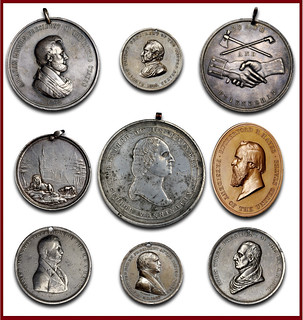
PREV ARTICLE
NEXT ARTICLE
FULL ISSUE
PREV FULL ISSUE
LARRY NESS INDIAN PEACE MEDAL COLLECTIONStack's Bowers will offer the Larry Ness Collection of Indian Peace Medals in November. Here's the announcement. -Editor
This sale was originally scheduled for March 2020 but was rescheduled for our November 2020 event, and promises to be a highlight among many important offerings. An edited, updated version of the sale catalogue will be prepared, and our online presentation of this collection reflects all of the edits.
To view all lots, see:
Here are some lots that caught my eye for various reasons. -Editor
Lot 2001: 1693 Louis XIV Felicitas Domus Augustae Medal 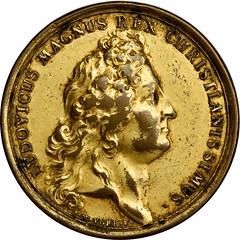
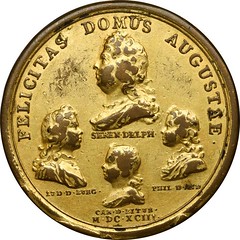
1693 Louis XIV Felicitas Domus Augustae medal. Copper, Gilt. Betts-Unlisted, types similar to Betts-75. Extremely Fine. 41.1 mm. 404.3 grains. Obverse signed I. MAVGER F. Obv: bust of Louis XIV, right. Rev: bust of the dauphin over those of his three children. Mellow golden gilt surfaces are reasonably intact for a worn medal, although the gilding is worn through on the highest points of the portrait reliefs on both sides and to a lesser degree on the tops of the letters of the legends. No serious marks or problems, though there is a bit of surface debris caked in places. Rim cuds on the reverse from 5:00 to 8:00. This was one of a series of medals struck to celebrate the prosperity of the Royal House. The first of this series, Betts-75 was officially presented to Native Americans, while some others are thought to have drifted into Native hands through unofficial channels. Part XVI of the illustrious Ford sales included two such medals in silver, though they were from different dies than seen here. As this has no manner of suspension, it was likely not presented to a Native American, yet it is a useful representation of those that were so used by King Louis XIV. Provenance: Ex Stack's, January 2010, lot 6192.
To read the complete lot description, see:
Lot 2002: George III and Queen Charlotte Medal 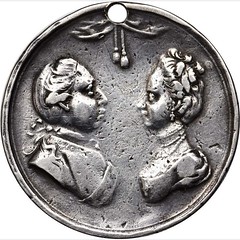
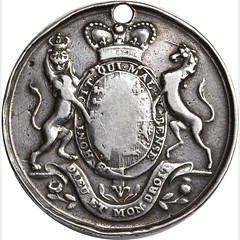
Circa 1761 George III and Queen Charlotte medal. Silver. Adams 11.2 (Obverse 1, Reverse B), Betts-440, Jamieson Fig. 10. Fine. 37.7 mm. 246.9 grains. Pierced for suspension. Unsigned dies. Obv: facing busts of the king and queen, drapery above. Rev: the royal arms and supporters. Light silver gray with some deeper patina in the recesses. A slight bend in the relatively thin flan is noted, as are a few scattered nicks and marks consistent with a medal worn in Native American context as is believed to have been the case with some of these marriage medals. The suspension hole is expanded from use, with the upper edge quite thin, but unbroken. Of the 13 medals accounted for in John Adams' Census, nine are included in institutional collections leaving precious few for collectors. There are more specimens about, to be sure. One in Adams' own collection was acquired after he published, and this one also seems to have been unknown to him in 1999. This said, they are indeed rare and this piece has a couple of useful distinctions. First, it was clearly worn. The two Adams Collection specimens were much better preserved, and one was suspiciously so for a medal believed distributed to Native Americans. The Ford specimen was unpierced. This example is far less questionable as an issued medal. It is also from Adams' Reverse B, by far the rarer of the two. Adams noted in 1999 that just one of the 13 medals in his Census was from this reverse die, a medal in the Glenbow Museum. There is one other from the W.W.C. Wilson sale that is now in the ANS. Inexplicably, while it was plated in the Wilson sale with an apparently plugged hole, at the ANS it has an added suspension loop. This is a third example from this reverse. Provenance: Ex Stack's Bowers Galleries, January 2013, lot 10108. Rare piece - a marvelous used example. -Editor
To read the complete lot description, see:
Lot 2014: Hudson's Bay Company Indian Peace Medal 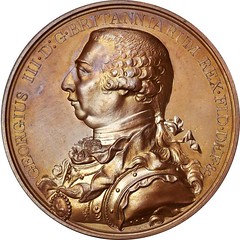
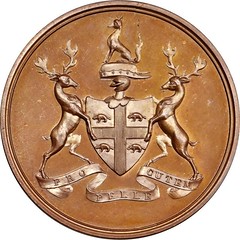
Undated (circa 1820) George III Hudson's Bay Company Indian Peace medal. Copper, Bronzed. Eimer-1120, BHM-1062, Jamieson Fig. 20. Choice Mint State. 48.0 mm. 867.3 grains. Obverse signed C.H.K. (C.H. Kuchler). Obv: older mantled bust of George III, left. Rev: arms of the Hudson's Bay Company. Rich chocolate brown surfaces with strong golden highlights at the rims that fade into soft golden green accents in the fields. Deeply prooflike with strong mirrors that contrast sharply with the satiny devices. Traces of soft violet are also noted on the obverse. Struck from a cracked reverse die as usual, the small series of breaks near 12:00 connecting the fox to the rim. A most handsome specimen. Provenance: Ex Stack's Bowers Galleries, February 2015, lot 18. Beautiful piece with strong obverse portrait. -Editor
To read the complete lot description, see:
Lot 2060: 1841 John Tyler Indian Peace Medal 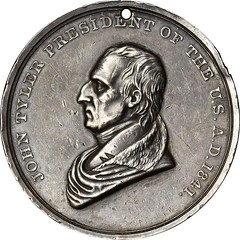
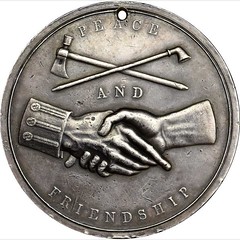
1841 John Tyler Indian Peace Medal. Silver. Second Size. Julian IP-22, Prucha-45. Extremely Fine. 62.3 mm. 1554.4 grains. Pierced for suspension as typical, with all piercings consistently positioned on the medals observed by us, both with respect to the obverse and reverse designs. Mostly deep gray silver with lighter gray high points that serve to accentuate the design features a bit. Soft blue iridescence in the fields on both sides. Another very handsome medal, this combining the desirable attributes of quality and clear evidence of having been issued and worn. Numerous small nicks are seen, as are small rim bumps, the largest being over THE on the obverse and an ideal identifier of this specimen. Initials are lightly and somewhat crudely cut into the right obverse field and appear to be "HSD" or "HSB." While elsewhere in numismatics "graffiti" of this nature is seen as a negative, on Peace medals it may allude to a past owner and perhaps the original recipient. As such, it is the writer's most favored type of "impairment" to discover on one of these medals. Even when it can't possibly lead to the identity of a specific human hand, it speaks to a degree of pride in ownership. These were never intended to be protected in cabinets of collectors and as such the signs that they were valued during their periods of use are different what might be used by numismatists. The medals for John Tyler mark a change in the production methods for the Peace medal dies. Instead of hiring die-sinkers to engrave the dies directly, the Mint elected to use its new portrait lathe to cut the dies from a prepared model. This saved both time and expense. Between December 1842 and January 1843, the entire order of John Tyler medals in silver was delivered. This is reported to have been 60 in large-size and 100 each in the medium and small-size medals. It remains unknown how many of the medals were actually distributed, but, according to Prucha, more than 40% of the original mintage, by weight, was returned to the Mint and melted for use in making the James Polk medals. From the writer's survey of specimens, it seems that the medals may have been distributed in roughly equal numbers, as those located today are roughly the same in number for each size. Of this size, seven distinct medals have been accounted for, with three in the collections of the ANS, the Gilcrease Museum and the Jefferson National Expansion Memorial in St. Louis. Provenance: Ex F.C.C. Boyd Estate; John J. Ford, Jr.; Stack's sale of the John J. Ford, Jr. Collection, Part XVIII, May 2007, lot 111; Stack's, January 2008, lot 7142. Great medal. I agree that signs of use add to the appeal. -Editor
To read the complete lot description, see:
Lot 2082: 1853 Franklin Pierce Indian Peace Medal 
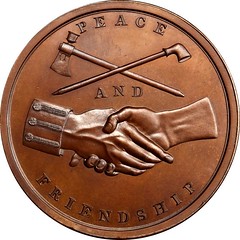
1853 Franklin Pierce Indian Peace Medal. Copper, Bronzed. First Size. Julian IP-32, var. Prucha-Unlisted. MS-66 BN (NGC). 76.5 mm. 3750.1 grains. A superb specimen of this very rare muling combining the original obverse for the issued Pierce medals with the second Peace and Friendship reverse, cut in 1846. Beautiful light mahogany patina with faint flecks of orange. Bold satin luster and really nice eye appeal. The obverse is essentially free of any marks save for a couple of microscopic spots, while the reverse has a slightly larger spot off the left index finger point, a small rim bump at the E of FRIENDSHIP and a couple of small marks in the upper field. This is a very rare muling of which we have only seen one other in our sales, that we recall. This one was in our Ford Sale, Part XVIII, and then in our January 2011 sale where the present owner bought it. There was an example in the 1986 David W. Dreyfuss Collection sale, and one in Presidential Coin and Antique's sale #38 (May 1985). The latter was referenced as the sole auction appearance Carl Carlson was aware of in 1986. In the Presidential sale, Joe Levine commented that he was aware of only one other auction appearance, in the Kessler-Spangenberger sale in 1981. Levine was caught in the trap set by an overly overlapped auction plate, with most of the reverse covered. In fact, that was a different muling, the Pierce obverse paired with the pre-1846 Peace and Friendship reverse. While we have not exhaustively studied all sources for another example, it is worth mentioning a second time that Carlson and Levine knew of only the PCAC auction example. This could be the same one, or that one could be the Dreyfuss piece, but this one is not the Dreyfuss medal. There was no provenance recorded in the Ford notes, and the PCAC plate is of such low quality (an unfortunate standard of the time) that one can't be certain it's a different medal. Whatever the case, it is a great rarity, with perhaps only two or three known. Provenance: Ex John J. Ford, Jr., Stack's sale of the John J. Ford, Jr. Collection, Part XVIII, lot 142; Stack's, January 2011, lot 6233. Beautiful medal! -Editor
To read the complete lot description, see:
Lot 2110: 1891 Sioux Wars Medal 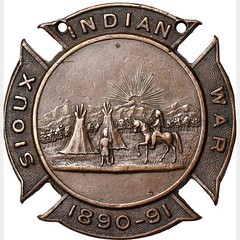
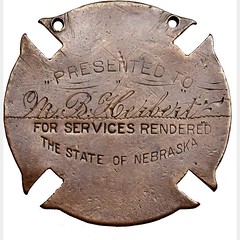
1891 Sioux Wars Medal issued by the State of Nebraska. Copper. Very Fine. 38.0 mm (drop only). The ornamental pinback hanger is lost. Deep chocolate brown surfaces, with a few light scratches and marks noted under magnification. As with the above example, the reverse is stamped with: PRESENTED TO / FOR SERVICES RENDERED / THE STATE OF NEBRASKA, and engraved to: M.B. Herbert, but without any rank or regimental assignment. Private Herbert was a member of Company H, 1st Regiment, according to a roster of recipients. Another example of this very rarely seen artifact of the 1890-1891 Sioux Wars that included the Wounded Knee Massacre. Remarkably, though it has been formally acknowledged by resolution of both houses of the American Congress as worthy of "deep regret," at the time, 20 participants were awarded the Congressional Medal of Honor for their parts in the affair. I'd never seen this before. Neat item. -Editor
To read the complete lot description, see:

Wayne Homren, Editor The Numismatic Bibliomania Society is a non-profit organization promoting numismatic literature. See our web site at coinbooks.org. To submit items for publication in The E-Sylum, write to the Editor at this address: whomren@gmail.com To subscribe go to: https://my.binhost.com/lists/listinfo/esylum All Rights Reserved. NBS Home Page Contact the NBS webmaster 
|
